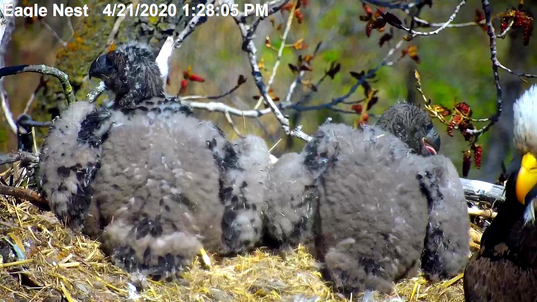|
April 24, 2020

Our two little nestlings are not so little any longer. They are approaching almost adult size by now. They are a little over five weeks old and it is all about feather growth and strength development from here out. The blue feathers emerging from the chicks' wings and tail are the blood feathers.
What are blood feathers?
When the feathers first emerge they are called pin feathers - or blood feathers. The shaft is filled with blood while it is growing in and shuts off when complete.
The blood is in the calamus or hollow shaft of the feather. In order for the feather to grow it needs a blood supply. The shafts (of feathers) grow from a follicle in the skin - and are rather like veins since they are connected to the eagle's blood supply. When the feather has come in completely the follicle closes and the blood will dry up inside of the shaft. The blood is red, the shaft appears blue because light is diffused by the covering. Also, the blood inside is dark red and exhibits poor light reflection.
How many feathers does an eagle have?
A Bald Eagle has approximately 7,000-7,200 feathers. However, that depends on when the feathers are being counted. When going through molts eagles have less and at other times have many more.
What are feathers made of?
Feathers are made of keratin, like their beak. The feathers have tiny interlocking structures called barbs which the eagle can be seen ‘zipping’ up when preening - meaning they are rejoining the barbs together - as the feathers will separate. Due to the construction of the feather, it is very light, but strong.
What are the parts of the feather called?
A typical wing feather consists of a central, stiff shaft with the softer vanes on each side. The leading edge of the feather during flight is called the outer vane. The opposite vane is wider than the outer vane and is referred to as the inner vane. The trunk of the feather is called the central shaft.
Characteristics of Primary Wing Feathers:
Primaries are the outer wing feathers, attached to the bird’s small, fused “hand” bones. Most groups of birds have 10 primaries. The front primary feather is relatively narrow, but stiff and is used to break the wind in flight.
Watch as the feathers develop over the next several weeks and see if you can name each feather part! They are preparing to use their feathers and wings just like their parents do and you can almost picture it already!
Special thank you to everyone who has donated to the Nongame Wildlife Fund! Your contributions make it possible for our hard-working team to bring this 24/7 spectacle into homes and classrooms around the world. We couldn't do it without your support.
|